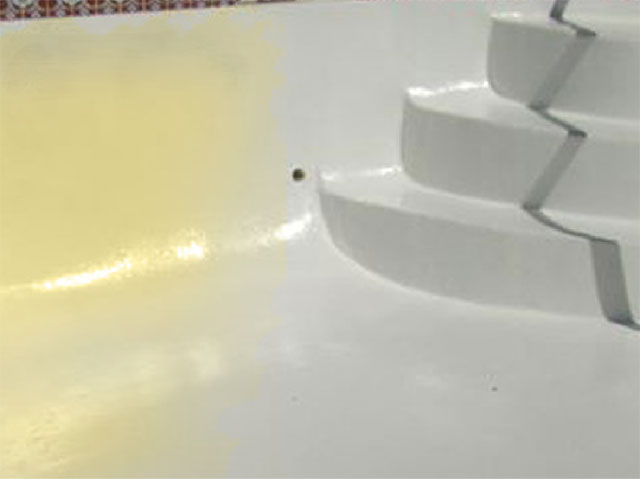Acid Wash Pool Cleaning: Putting Stains Down the Drain
Servicing Chandler, Gilbert, and the Phoenix metro area.
Does your pool surface seem grimy? Is your pool water looking dirty? If so, it might be time to dive into acid washing. At Arizona Bead Blasting, most of our clients require this pool cleaning method about once every five years — even if you regularly clean your pool and keep it in tip-top condition.
What is Acid Wash Pool Cleaning?
An acid wash is a popular choice for removing tough stains and algae from plaster and PebbleTec® pools. A mixture of water and hydrochloric acid, also known as muriatic acid, is sprayed onto your pool’s surface to remove grime and build-up. Stains left by chlorine, algae, minerals, and plain dirt miraculously disappear. That’s because when the acid makes contact, it gently removes a small layer of plaster from the surface, revealing a fresh, bright, and clean layer underneath. Because this type of cleaning is intense, it’s best suited to removing tough surface stains.
What will acid washing remove?
Besides the embarrassment, acid washing will remove unsightly stains, grime, and that telltale white line caused by hard water (Arizona is notorious for this), metals, and dirt.
- Magnesium stains — Too much magnesium in your water can cause pink, red, or black discoloration.
- Copper stains — Well water is typically high in minerals like copper and can stain your pool blue, green, or black.
- Hard water stains — Calcium deposits, or scum, are often found along your pool edge where tile meets water and can cause cloudy water and an unsafe pH level.
- Algae growth — Caused by lack of pool cleaning, improper pool pH balance, and low pool circulation, algae can cause health issues and clogged pool filters.
How often Should My Pool Be Acid Washed?
Truth: acid washing is like bringing out the big guns — it’s not to be taken lightly or done too frequently. If you regularly clean your pool and keep it in good shape, chances are you’ll only need to acid wash your swimming pool every 5-7 years. But because acid washing uses harsh chemicals, it’s not recommended to get your pool acid washed more frequently than that, as the harsh chemicals used can damage your pool’s surface.
Fun fact: A pool’s plaster coating is at least ½ inch thick, and the acid only removes a thin layer.
Plaster Pools: Our Whiter, Brighter, Gunk-Fighter
Only inground concrete or gunite pools can be acid washed. For best results, the plaster needs to be in good shape. If the surface is thin, cracked, or pitted from an improperly conducted acid wash, it can damage the surface even further. Acid washing won’t fix all problems; sometimes, resurfacing is the only option. It’s not recommended for fiberglass, acrylic, or vinyl-lined inground or above-ground pools. The acid will eat right through the material. Arizona Bead Blasting will inspect your pool and set proper expectations before we start the cleaning process.
PebbleTec Pools: Restoration that Rocks
PebbleTec pool finishes are known for their unparalleled natural beauty, durability, and longevity. Acid washing is a good option for cleaning stains and unsightly white rings on PebbleTec pools if the PebbleTec is intact. This means no cracks or chips are present. Muriatic acid also can be used in PebbleTec saltwater pools to remove accumulated calcium hardness buildup on salt cells.

 our acid
our acid
wash Process
Step 1: First, we drain the water from the pool, removing any leaves or debris as the water level drops.
Step 2: Once the pool is empty, we spray the pool walls with water. We then pour an acid/water mixture down the side of the wall (applying to one section at a time).
Step 3: After approximately 30 seconds of allowing the acid to work, we scrub the wall using an acid brush.
Step 4: We rinse the wall and continue working around the pool until every section has been treated.
Step 5: The acid-wash water at the bottom of the pool is neutralized using soda ash.
Step 6: The mixture is pumped into a storm drain using a submersible pump.
Step 7: The pool is rinsed once more, pumped, and refilled.
Step 8: The pool is now so inviting that everyone wants to cannonball in!
